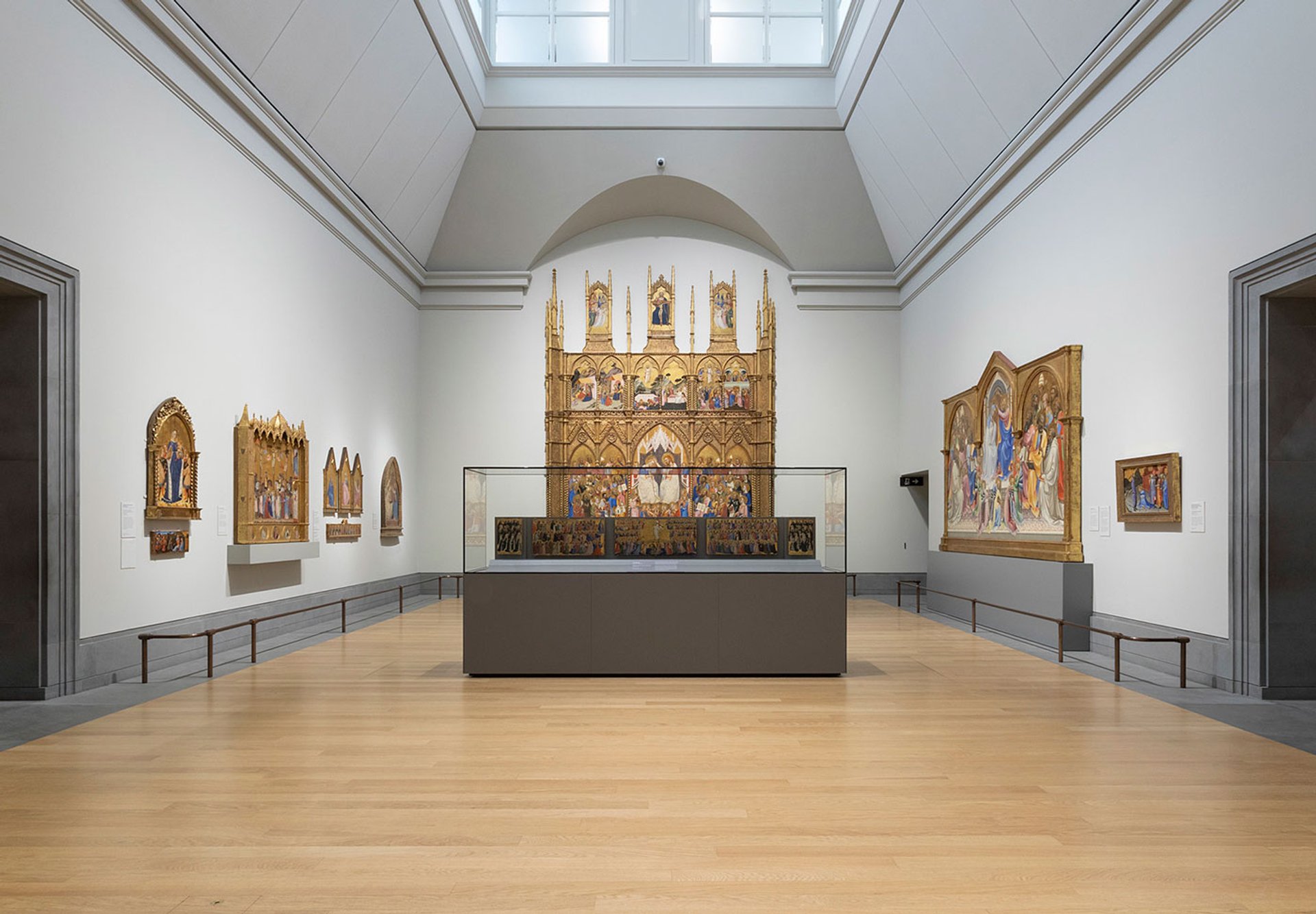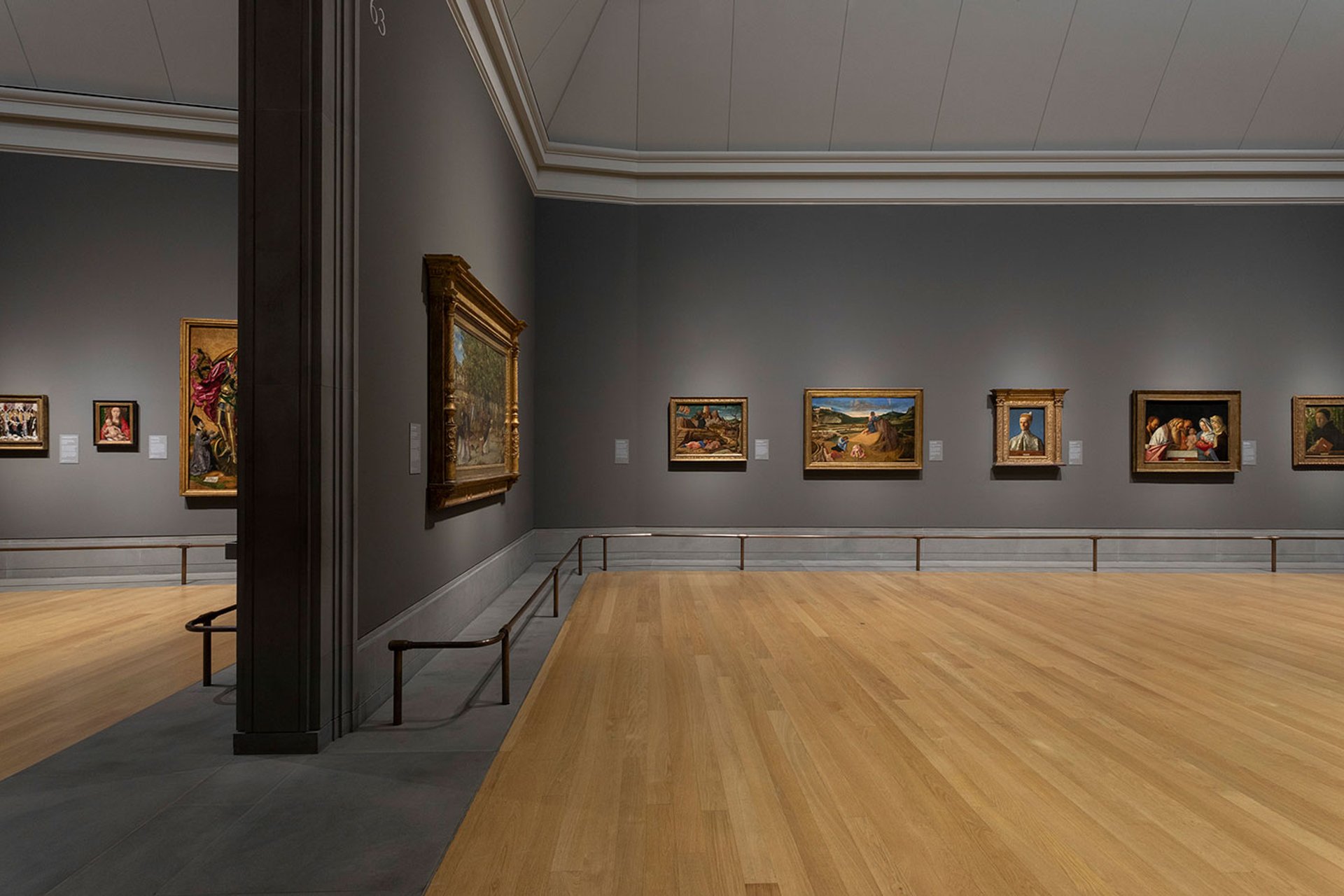The Big Review | The reopening and rehang of the Sainsbury Wing, National Gallery, London ★★★★★
I was bereft when the National Gallery closed the Sainsbury Wing to facilitate the creation of “a more welcoming entrance”, led by the architect Annabelle Selldorf. For me, it has always been a home from home: a place to experience the serene beauty of a Florentine church in the heart of London. It was deliberately designed that way by the postmodernist architects Robert Venturi and Denise Scott Brown in 1991—the perfect setting for the gallery’s unrivalled collection of early Renaissance pictures. Extending the original 1830s Wilkins building at the piano nobile level, the Sainsbury Wing allows one to nimbly traverse the history of Western European art along a vista stretching from Raphael’s Mond Crucifixion to George Stubbs’s Whistlejacket.
Has the reopening been worth the wait? Unreservedly, yes. Old favourites, such as the airy chapel-like space purposefully designed for the luminous works of Piero della Francesca, are back. The gallery is celebrating its bicentenary with an ambitious collection rehang across the two buildings, titled C C Land: the Wonder of Art (after its Hong Kong property developer sponsor). The long closure gave it the opportunity for new restorations, fresh curation—which plays with Venturi and Scott Brown’s famous vistas—and some resplendent reframing. The effect is revelatory.
Selldorf’s remodelling now definitively makes this the main entrance to the National Gallery. Working within the confines of the Grade I-listed building, she has opened out and illuminated the ground floor, with two cutouts in the ceiling to create grand double-height spaces. The old obstructive columns are gone and the once-darkened windows let the light in. Having been “blessed with a childhood full of museums”, Selldorf says her instinct is to make visitors feel comfortable. Her architecture is, therefore, all about “attitude” rather than “form”. You enter the gallery from a new ‘piazetta’ linking to Trafalgar Square. Transparent gates give onto a vast vestibule designed to welcome (and better manage) the crowds, with a revamped auditorium below.
Piero della Francesca’s Resurrection is back in the airy chapel-like space of the Sainbury Wing gallery that was purposefully designed for his work in 1991 Photograph: The National Gallery
At the top of the original asymmetrical staircase—past the wall of windows and Giorgio Locatelli’s first-floor restaurant, complete with Paula Rego’s Crivelli’s Garden mural—you are greeted by a new contemporary commission: Richard Long’s Mud Sun. Personally, I miss Francesco Botticini’s Assumption of the Virgin (around 1475), which once hung there. It gave the impression of ascending from a darkened crypt to catch a first glimpse of the heavens. Fortunately, visitors won’t have to wait too long for that.
There are no prescribed routes as you enter the Sainsbury Wing’s 17 galleries, which are untouched by the Selldorf renovation. What immediately impresses is the purity of the cleaned-up architecture, from the blue-grey pietra serena stonework to the re-bronzed rails that discreetly guard the pictures. In the first gallery, the mysterious cavernous landscape of Leonardo’s Virgin of the Rocks ushers the viewer into the hushed cave-like space behind it—the niche for Leonardo’s grand presentation drawing, the Burlington Cartoon. Large freestanding vitrines, inspired by the ‘statement’ cases of the Rijksmuseum in Amsterdam, display masterpieces such as the Wilton Diptych. These enable Medieval and Renaissance art to be experienced as material objects as much as masterpiece images—from portable diptychs to detached altarpiece predellas, to painted panels adorning wedding chests.
Nothing quite prepares you, though, for the soaring central enfilade, evoking the great nave of an Italian basilica with a knockout sequence of altarpieces. Here, the concerted efforts of all the specialists at the National Gallery—curators, conservators, framers, restorers, light designers and engineers—bear fruit. At one end, as before, sits Antonio and Piero del Pollaiuolo’s The Martyrdom of St Sebastian, newly restored to reveal the joys of its chromatic as well as its figurative juxtapositions. Opposite is the reconstructed San Pier Maggiore Altarpiece by Jacopo di Cione in all its gleaming monumentality. The width of the space it occupies almost exactly matches that of the Benedictine convent (now destroyed) where it originally hung.

“Gleaming monumentality”: The reconstructed San Pier Maggiore Altarpiece by Jacopo di Cione is mounted on a plinth at one end of the main “nave” of the Sainsbury Wing galleries. In front of it, Fra Angelico’s altar panels from San Domenico, Fiesole, are presented lower than before to emphasise their predella function Photograph: The National Gallery
Expertly reframed by Peter Shade, both works are mounted on low grey plinths that are reserved for significant altarpieces throughout the display. A long central vitrine in front of the Cione contains Fra Angelico’s wondrous altar panels from San Domenico, Fiesole, presented lower than before to emphasise their predella function. Segna di Bonaventura’s Crucifix is suspended from the ceiling, a bold idea that mimics how painted crucifixes were commonly hung at an angle above the choir screen in 14th-century Italian churches. The result is a ‘trinity’ of layered viewing experiences, with the Fra Angelico almost functioning as the lost predella of the Cione.
Along the enfilade we are treated to 100 years of artistic development, looking from Cione’s gold-surrounded angels (1370-71) to the Pollaiuolo brothers’ imposing perspectival landscape (mid-1470s), via Cima da Conegliano, Carlo Crivelli and Matteo di Giovanni. Panels from Duccio’s majestic Maestà are soon to return from their temporary display downstairs in Siena: The Rise of Painting, 1300-1350 (until 22 June).
The smaller, squarer rooms to either side are more suggestive of domestic spaces. It is a fitting ambiance for the four Northern Renaissance galleries, where you will find Jan Van Eyck’s Arnolfini Portrait. Several later German and Netherlandish masterpieces have been relocated from the Wilkins building, notably Pieter Bruegel’s Adoration of the Kings (1564), alongside Hieronymus Bosch and Holbein, to address the collection’s historic bias towards the Italian Renaissance (roughly a third of the gallery’s total 2,400 pictures). They are rather a jolt in terms of chronology. Catharina van Hemessen’s Portrait of a Woman (1550), the only work here by a woman artist, has been given space on its own, and seems correspondingly lonely and detached.

Giovanni Bellini’s Doge Loredan (second right) effortlessly holds sway in a room devoted to Venice in the Sainsbury Wing Galleries Photograph: The National Gallery
The themed rooms, ‘Gold’ and ‘Looking at Nature’, allow for different art-historical lenses. The latter contains some tiny landscape wonders, although Pisanello’s aristocratic visions seem slightly out of place. His fellow court artists—catering to the princely tastes of Ferrara, Mantua and Urbino—have been largely exiled to Room 14 in the Wilkins building, including most of the gallery’s Mantegnas. Raphael, whose works amply grace the Sainsbury Wing, is now at one remove from the Justus of Ghent panels he grew up with in the ducal court of Urbino. However, this is not a static hang like the V&A’s Renaissance galleries, and will change over time. So I remain hopeful that the exiles will return.
More rewarding are the rooms devoted to Venice and Florence. One has the sense of moving from the rich trappings of a Florentine palace—where pictures like Sandro Botticelli’s Mars and Venus were literally part of the furniture—to the lyrical and expansive feel of a Venetian palace overlooking the Grand Canal. Giovanni Bellini’s Doge Loredan effortlessly holds sway in Venice, while Florence has a central vitrine highlighting Francesco Pesellino’s Story of David and Goliath wedding-chest panels, which are powerfully juxtaposed with Paolo Uccello’s restored and reframed Battle of San Romano in another feat of layering (horse upon horse).
For Selldorf, the soul of her architectural intervention lies in the true meaning of ‘public realm’—a village or a small city of people who talk to one another, and a place for individuals just to be. The Sainsbury Wing pictures, too, inhabit spaces where they can comfortably reside, converse with one another and the viewer, or, as with Jacopo de’ Barbari’s Sparrowhawk, find a perfect perch of their own. Happily, as Per Rumberg, the National Gallery’s head of curatorial, explains: “The pictures led the way; we didn’t want to be too clever.”
- Curators: Christine Riding, director of collections, and Per Rumberg, head of curatorial
- The Sainsbury Wing reopens on 10 May as the main entrance to the National Gallery, London. Open daily 10am–6pm and Friday until 9pm.
- Tickets: The National Gallery is free to visit, but there is a charge for some exhibitions. Free tickets can be booked in advance for fast-track entry.




